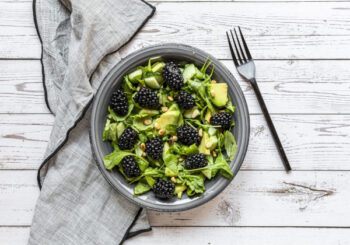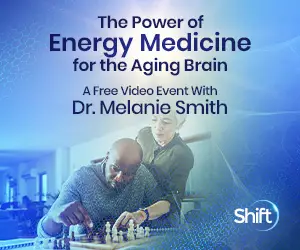Guest Writers for Wake Up World
Have you ever wondered if “eating raw” is right for you? Have you ever felt confused as to what exactly the raw food diet even is? No matter how familiar you are (or aren’t!) with a raw food diet, this article is for you! In this article, we hope to clear the air and cut the confusion about all things raw by presenting both “the pros and the cons” of the diet, based on what experts are saying as well as the latest research.
So hang on to your Vitamix, and let’s get ready to “deep dive” into all things raw!
What Is the Raw Food Diet?
The raw food diet, also called raw foodism or raw veganism (if raw meat and dairy are not included), is a diet where a person eats mostly raw, organic, unprocessed foods. A particular food is considered raw if it has not been heated over 118 degrees Fahrenheit.
Eating raw lets you employ unique and creative ways of preparing foods without ever turning on a stove. This includes blending, dehydrating, sprouting, soaking, and juicing. Vegetables, fruits, nuts, and seeds make up a large part of a raw food diet. However, some raw people choose to also eat wild-caught raw fish and free-range meats as well as raw free-range eggs and raw organic dairy products such as cheese and yogurt.
The Pros of the Raw Food Diet
We know that your unique “right way of eating” is just waiting to be discovered. Will it be a raw food diet? Let’s take a look at some of the pros of going raw first to find out!
1 | Eating Raw Foods Keeps Enzymes Intact
Enzymes are absolutely essential to break down food. Some of the enzymes that we need for digestion include amylase and glucoamylase to break down carbs, alpha-galactosidase to break down sugars, bromelain and protease to break down proteins, and lipase to break down fats.
The importance of maintaining the integrity of live enzymes in foods was first brought to the forefront in the mid-eighties by Dr. Edward Howell, author of the best-selling book Enzyme Nutrition. He encouraged a mostly raw foods diet. His recommendations were based on his research into how enzymes help the gut as well as how key enzymes become depleted whenever we eat cooked food.
Howell considered live enzymes that exist in raw vegetables and fruits to be representative of the “life force” in foods that we can use to enhance our own life force as well. Modern research has confirmed that eating a primarily raw foods diet can change the gut’s microflora for the better.
2 | Eating Raw Means You Eat More Fruits and Vegetables
Most people wind up eating more vegetables and fruits on a raw food diet. This just makes sense because when certain things such as cooked meat, eggs, and cooked grains are off the menu, a person will naturally load up on things he or she can eat.
More fruits and veggies also mean more detoxifying phytonutrients, easily absorbable vitamins and minerals, and antioxidants. Individuals who committed to following the Hallelujah vegetarian diet, where 68-80% of total calories came from raw vegetables and fruits or sprouted grains, experienced significant “self-reported improvements in health and quality of life” after just 7 days.
3 | Eating Raw Means You Get More Fiber
More vegetables and fruits in the diet also means more fiber, which the majority of people do not get enough of. Fiber is vital for gut health, metabolism, and the prevention of chronic disease. According to the Mayo Clinic, the body needs both soluble and insoluble fiber for the breakdown of food into usable energy. Soluble fiber is found in plants such as citrus fruits, apples, and carrots, while insoluble fiber can be found in nuts and cruciferous vegetables.
4 | Eating Raw Means You Eat Less Junk
Eating raw also has its advantages in terms of what you leave out. Since the emphasis of a sound raw foods diet is on whole foods first and foremost, this leaves out most processed foods that can be sources of hidden sugars, preservatives, and additives.
5 | Many Foods Have More Nutrients In a Raw State
It is certainly true that many (although not all) fruits and vegetables have more bioavailable nutrients when they are in their raw form. For example, according to study results on men in the Netherlands in 2008, eating raw broccoli as opposed to cooked resulted in faster absorption and higher bioavailability of key phytonutrients, including sulforaphane.
A 2011 Swiss study also made the connection between the consumption of raw, organic cow’s milk, and less incidence of childhood asthma and hay fever.
Finally, a Finnish study conducted in the mid-nineties found that raw vegans had “significantly higher blood concentrations of beta-carotene, vitamin C, and vitamin E, as well as higher erythrocyte superoxide dismutase activity,” when compared to their omnivore counterparts.
6 | Eating Raw Helps You Lose Weight
Many studies have proven the weight loss/raw foods connection. A German survey on more than 500 men and women who had stuck to a strict raw foods diet for at least three years discovered an average weight loss of about 20 pounds in the men and roughly 26 pounds in the women. Other studies have reported comparable findings, in addition to lower diastolic pressure readings, in people who were on a raw foods diet for at least half a year.
Fruits and veggies can be filling because of their fiber content, which in itself can help you eat less and make better food choices. Fruits and vegetables are also considered “low energy density” foods, compared to meat. This means they have lower calories overall.
Interestingly, in one investigation published in the Southern Medical Journal, 80% of those who went on a raw food vegan diet for at least six months also “abstained spontaneously” from alcohol drinking and cigarette smoking as well.
7 | Eating Raw Foods Can Increase Longevity and Prevent Disease
According to many studies, eating a raw foods diet can lower your odds of developing common lifestyle-related diseases, including heart disease, diabetes, and cancer. Many people who switch to a raw foods lifestyle also experience increased energy levels, increased cognitive ability, reduced inflammation, and younger looking skin, especially during the first few months on the diet.
Eating primarily raw vegetables and fruits can sometimes reverse disease conditions too. One study found that individuals eating a vegan diet had significant improvements in symptoms of fibromyalgia, in large part because of higher amounts of antioxidants, fiber, and lactobacilli bacteria in their diet. Another Japanese study found that a low-calorie vegan diet helped individuals with rheumatoid arthritis.
In addition, utilizing one aspect of a raw food diet – fresh, raw vegetable, and fruit juices – has been shown to not only prevent but sometimes reverse active cancer states.
First, juicing makes the nutrients in a fruit or vegetable more digestible by the body, meaning more of the nutrients are extracted from the vegetables or fruits with less of the obstructing fibers. The second is that you can consume a lot more vegetables (particularly vegetables and fruits with cancer-killing nutrients) in a shorter amount of time and with a lot less effort.
The Cons of the Raw Food Diet
While some people thrive on the raw foods diet, other people do not fare as well, especially over the long term. Some signs that may indicate it may not be working for you include digestive upset, trouble sleeping, lackluster skin and hair, low libido, low energy, and feeling cold.
Here are a few “cons” of the raw food diet that may lead to trouble.
1 | Some People Cannot Digest Raw Foods and Vegetables
For individuals who lack the appropriate digestive enzymes, have an imbalance of gut flora, or have a serious gut-related condition, eating raw may do more harm than good. Gas, bloating, and pain is a sign that foods are not being absorbed properly in the digestive tract and may even be stagnating in the intestines, resulting in fermentation.
Sometimes raw foods can be introduced slowly. Other times, slightly steaming veggies can break the fibers down just enough so that they don’t lose their enzyme properties but are also much easier on the system.
2 | From an Ayurvedic Perspective, Raw Is Not Always Best
Although some raw foods are encouraged, Ayurvedic experts caution about eating too much of them. In Ayurveda, nutrition is measured not just by the foods we eat, but also by our body’s natural ability to break those foods down and convert them into energy.
This “digestive capacity” is known as Agni, and it is quite unique to each person. In general, however, foods eaten in raw form are said to be Rajasic, meaning “activating or enervating.” They are also characterized as being light, rough, dry, and cold.
“Consuming foods with these qualities can strain our digestive fire and decrease our digestive capacity, particularly in someone who has weak digestion to start with,” says Valencia Porter, M.D., M.P.H., F.A.C.N., a certified Perfect Health instructor at the Chopra Center in La Costa, California. “This can lead to poor absorption of nutrients, lack of nourishment to our tissues, imbalances in our body, and, ultimately, illness or disease.”
3 | Some Foods are Healthier When They Are Cooked
One disadvantage of being a strict raw foodist is that you may be losing out on some key phytonutrients that have been shown to exist in higher amounts when cooked. For example, raw mushrooms contain toxins that are slightly carcinogenic to humans. The toxin, hydrazine, is neutralized when exposed to high heat, however.
Cooked shrooms may even be cancer-inhibitors. A 2008 study published in the International Journal of Cancer found that cooked mushrooms, in combination with matcha green tea, reduced the risk of breast cancer in Chinese women by 60%.
Other veggies whose healing power appears to go up with cooking include tomatoes, carrots, artichokes, and collard greens.
4 | When You Eat Raw, You May Not Be Getting Enough Protein
Getting adequate amounts of the right kinds of protein can be a problem for those who follow the strict raw foods diet. Experts say that it can be done, but it takes planning to make sure you are getting the right essential amino acids (protein is made up of amino acids) every day. Some raw foods that are higher in protein include hemp seeds, oats, and raw nut butters.
Green vegetables such as broccoli and fruits such as bananas contain some protein as well, although not as much as nuts, seeds, and grains.
5 | You May Be Missing out on Other Key Nutrients If You Go Raw
Besides key amino acids, going completely raw vegan may also leave you depleted of saturated fats, omega-3 fats, iron, folate, selenium, zinc, and vitamin B12.
While a deficiency in any of the above can have serious consequences, the most prevalent deficiency for raw foodists is vitamin B12. A 2005 study published in Oxford’s Journal of Nutrition found that while long-term raw foodists maintained very healthy serum LDL cholesterol and triglyceride levels, they suffered from elevated homocysteine levels as well as low serum HDL cholesterol, mainly due to significant vitamin B12 deficiency.
Symptoms of B12 deficiency are fatigue, heart palpitations, digestive upset, nerve problems, loss of vision, mood swings, and cognitive decline. Long term B12 deficiency has been linked to serious digestive system and autoimmune conditions as well.
Is There Just One Way to Create My Raw Foods Diet Plan?
The short answer is no!
You can eat a raw foods diet for part of the year (in the hotter months, for example). You can do an 80/20 or 60/40 diet. Or you can simply decide to replace one or two cooked meals a day with a raw option. You can also go mostly raw most of the time and decide to incorporate foods such as fish, fermented foods, eggs, meat, and sea vegetables into your diet as needed.
We suggest taking your time and having some fun on your food journey. Commit to adding more raw fruits and veggies onto your plate and mark your progress and insights in a food journal as you go along.
Discover What Works for You!
Let’s face it, not every way of eating is for everyone.
What could be a “miracle diet” for one person may be harmful for another. In the end, you decide what kind of eating works for you. You can discover this through getting key tests done, by looking at your history and habits, by using your intuition and by a lot of trial and error along the way.
Approach your healthy eating journey with an open mind and a sense of adventure. Then choose healthy eating habits that uniquely fit your lifestyle and situation. And as always, be sure to get the guidance of a physician, nutritionist, or health coach along the way if you feel you need extra support or you are dealing with a serious healing crisis.
Food really is medicine. It is up to you to discover which foods (and how much of them) can help you live your best, most vibrant life every day!
Sources and References:
- The Raw Food Diet: A Beginner’s Guide and Review
- 15.3 Digestive System Processes
- Enzyme Nutrition and Raw Food: Fact or Fiction?
- An uncooked vegan diet shifts the profile of human fecal microflora: computerized analysis of direct stool sample gas-liquid chromatography profiles of bacterial cellular fatty acids.
- Food and nutrient intake of Hallelujah vegetarians
- Dietary fiber: Essential for a healthy diet
- The protective effect of farm milk consumption on childhood asthma and atopy: the GABRIELA study.
- Bioavailability and kinetics of sulforaphane in humans after consumption of cooked versus raw broccoli.
- Antioxidant status in long-term adherents to a strict uncooked vegan diet.
- Consequences of a long-term raw food diet on body weight and menstruation: results of a questionnaire survey.
- Effects of a raw food diet on hypertension and obesity.
- Antioxidants in vegan diet and rheumatic disorders.
- [Effects of a low calorie vegan diet on disease activity and general conditions in patients with rheumatoid arthritis].
- Raw food treatment for cancer using vegetable juices
- Raw Foods: An Ayurvedic Perspective
- Hepatocarcinogenesis by hydrazine mycotoxins of edible mushrooms.
- Dietary intakes of mushrooms and green tea combine to reduce the risk of breast cancer in Chinese women
- Long-Term Consumption of a Raw Food Diet Is Associated with Favorable Serum LDL Cholesterol and Triglycerides but Also with Elevated Plasma Homocysteine and Low Serum HDL Cholesterol in Humans
- The 17 Best Protein Sources for Vegans and Vegetarians
- Vitamin B12: What to Know
Originally published at The Truth About Cancer and reproduced here with permission.
About the author:
 Ty Bollinger is a health freedom advocate, cancer researcher, former competitive bodybuilder and author. After losing several family members to cancer, he refused to accept the notion that chemotherapy, radiation, and surgery were the most effective treatments available for cancer patients. He began a quest to learn all he possibly could about alternative cancer treatments and the medical industry. What he uncovered was shocking. There is ample evidence to support the allegation that the “war on cancer” is largely a fraud and that multinational pharmaceutical companies are “running the show.” Ty has now made it his life mission to share the most remarkable discovery he made on his quest: the vast majority of all diseases, including cancer, can be easily prevented and even cured without drugs or surgery.
Ty Bollinger is a health freedom advocate, cancer researcher, former competitive bodybuilder and author. After losing several family members to cancer, he refused to accept the notion that chemotherapy, radiation, and surgery were the most effective treatments available for cancer patients. He began a quest to learn all he possibly could about alternative cancer treatments and the medical industry. What he uncovered was shocking. There is ample evidence to support the allegation that the “war on cancer” is largely a fraud and that multinational pharmaceutical companies are “running the show.” Ty has now made it his life mission to share the most remarkable discovery he made on his quest: the vast majority of all diseases, including cancer, can be easily prevented and even cured without drugs or surgery.
For more information, visit:

If you've ever found value in our articles, we'd greatly appreciate your support by purchasing Mindful Meditation Techniques for Kids - A Practical Guide for Adults to Empower Kids with the Gift of Inner Peace and Resilience for Life.
In the spirit of mindfulness, we encourage you to choose the paperback version. Delve into its pages away from screen glare and notifications, allowing yourself to fully immerse in the transformative practices within. The physical book enriches the learning process and serves as a tangible commitment to mindfulness, easily shared among family and friends.
Over the past few years, Wake Up World has faced significant online censorship, impacting our financial ability to stay online. Instead of soliciting donations, we're exploring win-win solutions with our readers to remain financially viable. Moving into book publishing, we hope to secure ongoing funds to continue our mission. With over 8,500 articles published in the past 13 years, we are committed to keeping our content free and accessible to everyone, without resorting to a paywall.








